
Rod-Land
The tragically underserved classic stands among the genre's greatest triumphs.
Rod-Land.
Though chosen for the titular wands wielded by its plucky fairies, the moniker is an odd and awkward one…conveying none of the game’s cheerful whimsy and deeper mystery. It’s a title that belies—that hides—the magic really inside.
For Rod-Land is both an adventure and a rite of passage. It’s about growing up and saying goodbye, of parental love and tragic sacrifice, of faith and hope and sibling devotion. It’s a harrowing quest squeezed into cutesy proceedings. It’s a fairy tale. A gauntlet of labors. The Hero’s Journey prescribed for two…all condensed into a poorly-titled, poorly distributed, poorly documented game of almost defiant, sublime design.
In the East, Rod-Land began as an arcade game, although images of a working cabinet remain as elusive as the game’s unicorn bunnies. Likely, it was conceived as a conversion kit for one of Jaleco’s other machines, which would explain why the game’s board/chipset is all that any collector seems to own in the current day. Fortunately, the game did eventually head West thanks to a number of quality home conversions; the Amiga port done by Storm/The Sales Curve is probably the most famed and celebrated. Americans, however, wouldn’t see an official Rod-Land release (notwithstanding some UltraCade inclusions) until Hamster’s Arcade Archives release in January 2021—over thirty years after the game’s initial conception. The game deserved better. Still deserves better.
For Rod-Land is a single-screen platformer (SSP) that both respects and rejects its former contemporaries—specifically, Snow Bros. and Bubble Bobble. Like the two classics, enemy elimination is the goal. Platforms must be navigated and bosses must be fought. But while the overall genre had become predisposed to a formulaic mix of jumping and flinging projectiles and battering baddies for artful combos, Rod-Land pivoted directions. It’s more measured, more methodical. Enemies are no longer shot from afar, but must be grabbed and thwacked. The biggest points are gained not by defeating monsters, but by avoiding them; passively prowling a stage for every bonus flower earns the bigger return. And most radical: no more jumping. The fairy pair can conjure a ladder at will, allowing them to chart their course across each stage’s web of tiers and platforms almost like an interactive game of Chutes and Ladders. Whether this mechanic trumps the “typical jump” is a debatable affair, but for Rod-Land’s deliberate rhythms, it works especially well.
The game’s endearing chemistry, however, comes as much from its characters as its gameplay. Rit and Tam, the game’s would-be champions, are siblings of a carefree existence. Everything is bright, sunny—perfect—in their cute fairy-land village. The very notion of evil is a foreign, faraway concept.
That is, until a monster suddenly abducts their mother and imprisons her atop the ominous “Maboots Tower.” Now alone in a world that no longer makes sense, these unlikely heroes must brave the unknown, thwarting woodland meanies and titanic beasts in a desperate hope to bring their mother home. Left with their father’s magical rods and the village elder’s ladder-conjuring boots, they aren’t without a modicum of help. But truly, their greatest treasure is each other—a sisterly/brotherly bond granting renewed strength and resolve against impossible odds. And in the end, it’s enough. More than enough. To both rescue Mom and banish the darkness.
It’s a fairy tale born of subtext, of course; the game’s clumsily translated, interstitial cutscenes are better at implying than outright providing the full tale buried within. But for those paying attention, the siblings’ story is of a classic, timeless vintage...with a modern twist.
Because unlike most games, Rod-Land comes built with a second-half—a sequel or “second quest” featuring an altogether different story. Where the first game featured 31 stages mostly set in the tower, the second entails a mysterious pyramid, replacing the former’s squishy, woodland foes with baddies of a more mechanical persuasion. The gameplay is the same, but the circumstances are weirder, creepier, and more precarious. Less straightforward fantasy and more disconcerting, cryptic mystery. If Part 1 is about saving the siblings’ mother, the second is about uncovering the fate of their vanished father. One is of love, loss, and recovery, the second of sacrifice and goodbyes and enduring legacy. It’s a simple story turned into an engrossing saga. And yet, for the vast majority of Rod-Land fans, the first episode is all they ever played or knew existed.
The gameplay is as layered as the narrative, featuring a dynamic difficulty designed for novices and veterans alike. Those wanting an easier sprint to the end can bash the baddies and swipe the items they leave behind. These one-time baubles are almost always overpowered, ranging from devastating TNT blasts to bouncing bombs to electric orbs that ricochet about the screen, annihilating everything. Sometimes within seconds. Conversely, score-centric players will favor a more passive approach, collecting the flowers scattered across each arena while avoiding the wandering critters. By not attacking, the blossoms’ point values bloom exponentially, and once the last in collected, the remaining enemies transform into bonus targets carrying one of five letters—E-X-T-R-A. Spell the word, and a comely fairy appears in a dream-like sequence, granting both a 1-up and 10,000 additional points. Not surprisingly, this pacifist style is the trickier way to play, although players can always alternate between the two extremes as needed.
And speaking of comely fairies, all of Rod-Land’s art is of storybook charm befitting its folkloric pedigree. Rit and Tam are naturally endearing in their almost fourth-wall breaking winks and nods, but their adversaries captivate in equal measure. Bunnies nibble carrots while riding balloons. Starfish toss boomerangs, then fall on their faces. Winsome snakes suddenly burst into tears as they break into sudden “freak-out” mode. Not to be outdone, the bosses are also delightfully bizarre, providing some of the game’s most inexplicable encounters. Even the backgrounds bear a certain personality, changing with each screen—with every step of progress—as the siblings draw slowly to the tower’s top, and later, as they descend into the pyramid's depths.
But what might truly guarantee Rod-Land’s classic status is its underappreciated musical score, which alternates generously between certain scenes, settings, and enemy encounters. It opens boldly, a blare of optimistic horn trumpeting the children’s approach as they near the tower. But eventually, as the dangers mount, the melody shifts to a more meandering, melancholic tune…suggesting, perhaps, the wistful memories of childhood gone and innocence lost. And later, in the aftermath of the great climax, the story concludes with a synthy, symphonic embrace only surpassed by the heartfelt hug shared between mother and child. It’s all subtle but unforgettable. And one every self-respecting gamer should seek the soundtrack for.
Rod-Land isn’t flawless. It feels a little rushed—a little bit glitchy—with unmistakable slow-down and a few other curious quirks. And yet, the niggles hardly matter against the unique, overriding experience it so generously proffers; a parable of character, soul, and destiny hidden like a letter between the pages of a bigger, but not necessarily better, book of stories. If not the genre’s best platformer, Rod-Land is certainly the most meaningful.
A game praying, to this day, to be played.--D

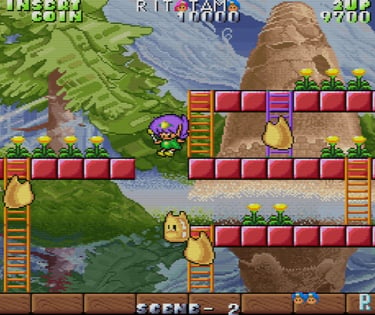


Rod-Land
Publisher: Jaleco
Developer: Jaleco
Release: 1990
Genre: Single-screen Platformer
Platform: Arcade
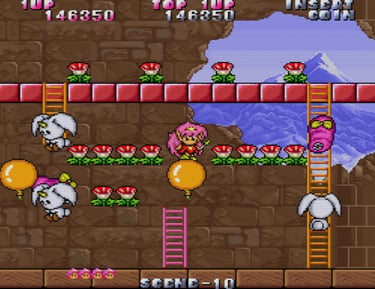

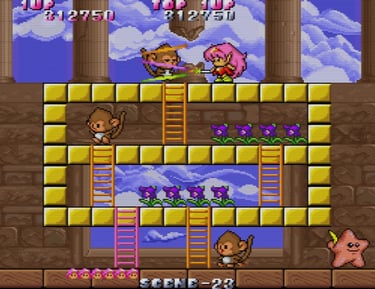

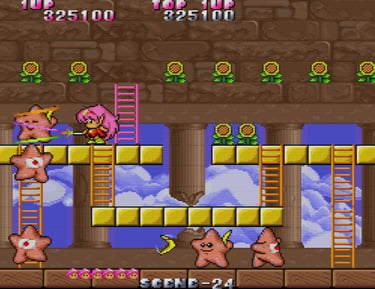

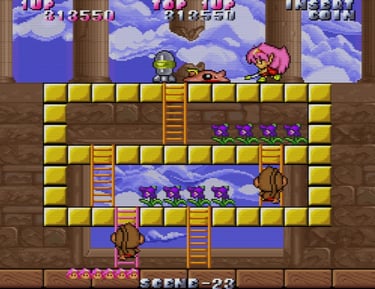

Rit (top) and Tam (bottom) are siblings...but not sisters! It's a common mistake--even some of the game's European conversions mistook the lad for a blue-haired lass. But Tam's not only a boy...he's also Player 2, a rather unusual, even subversive, switcheroo for the time.
The wands first grab and trap an enemy, as seen in the upper picture. Now immobilized, the baddie can be whapped back-and-forth across the ground (as seen in the bottom shot). Three hits equals defeat. It's a comically cute n' brutal attack thanks to the cartoony proceedings.
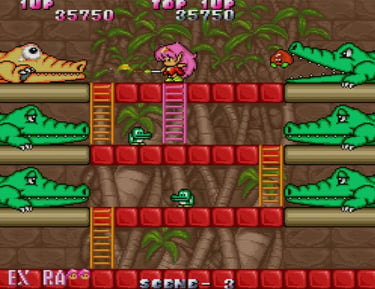

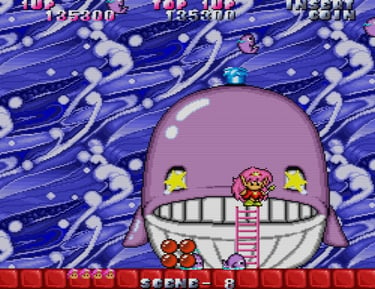

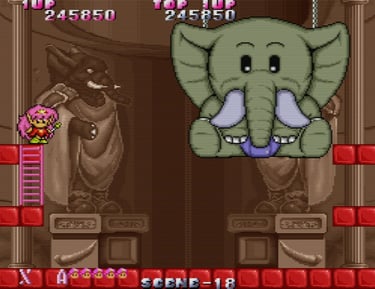

Boss fights border on the surreal and make little sense...but do make the game all the more distinctive and memorable.
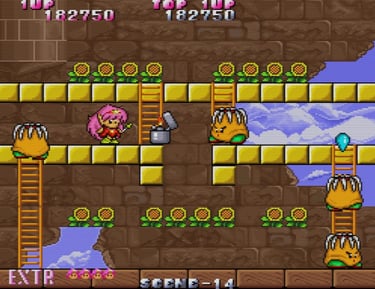



Ever contrarian, Rod-Land even reworks the established powerup paradigm: items are a one-use affair, offering either singular or timed attacks. Here, a lighter grants Rit a flaming, fleeting burst of invincibility.


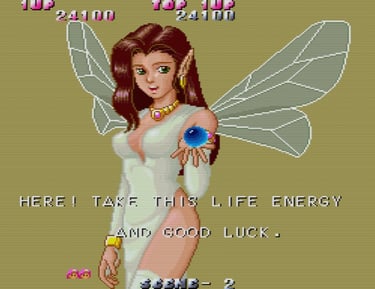

Rod-Land's artwork is superb, as seen in these two comely fairies bestowing their bonus bounties. The upper lass represents the game's first quest, the bottom girl assists with the second. Both raise a serious dilemma: who's the finer of the two?




As shown, powerups reap fruit cards from fallen foes, granting yet another way to earn big points. It's definitely a less dangerous approach than scurrying for the flowers situated in every awkward spot of the stage...but the rewards are also smaller.
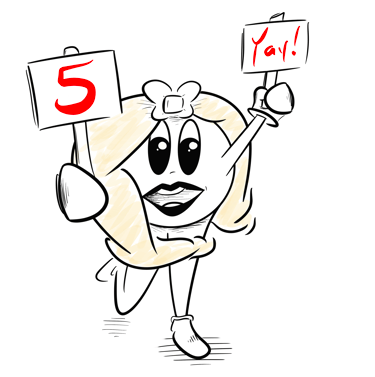




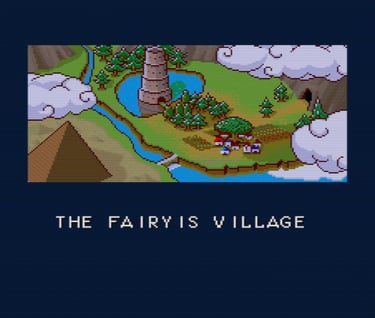

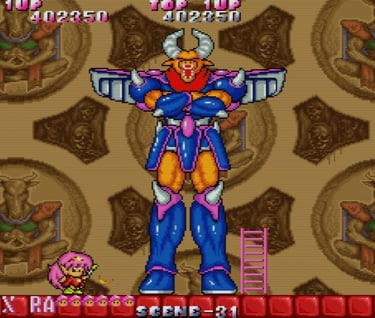
Collecting all the flowers triggers the "EXTRA" mini-game.
A quick shot of the Fairy Realm reveals a neighboring pyramid, subtly foreshadowing the events of Part 2. (A fact lost on every developer who ported the game to other systems.)
Part 1's final boss has four forms; the demon ultimately wields a set of flight-granting afterburners. It seems nonsensical to the casual player, but for those who continue with the sequel, it's an excellent hint of what's to come.
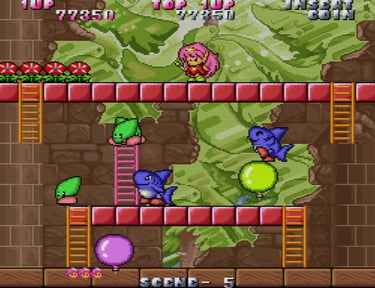


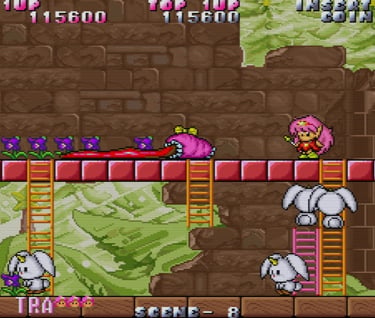
Enemy design, if weird, is also inspired--note the many varying expressions of the Sharks as seen between the two pics.
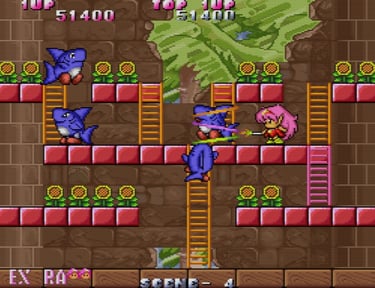

Not all the baddies are cuties. Check the tongue on that one!
Saving Mom provides a heartful finale that might be enough for some. But for those curious about Dad will have to accept the game's semi-hidden second quest.
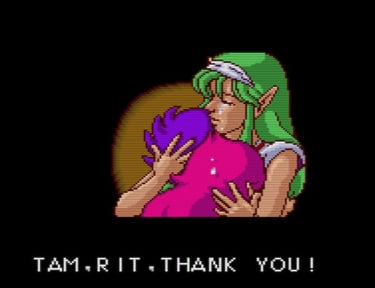

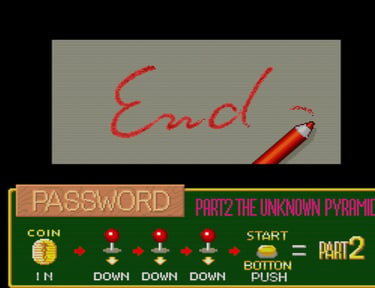

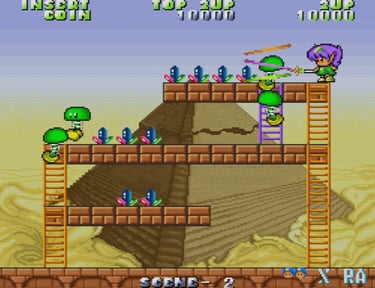


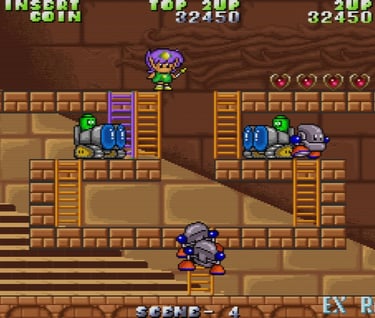
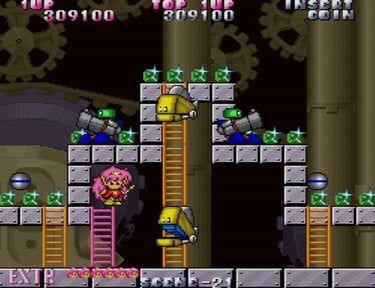

For those who dare, players can try Part 2, "The Unknown Pyramid." It plays the same as its predecessor, but features new stage arrangements, enemy designs, bosses, and most importantly, a sequel story that leans more into mystery.
As in Part 1, the art design is excellent with backdrops that change (and proceed) with every scene.
The first game was about reaching the topmost floor; the sequel sees Rit and Tam descending to the deepest. It makes for a good juxtaposition between light and dark, life and death, Heaven and Hades.

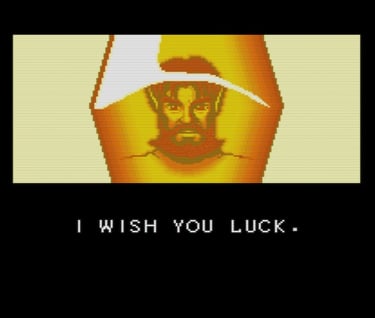
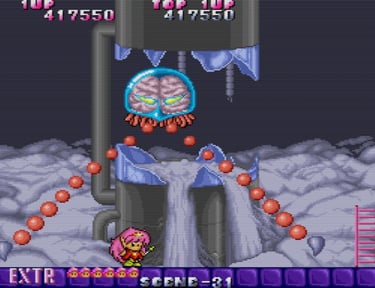



The siblings' father, through the magic of their rods, provides some last words of encouragement.
The sequel's final boss subverts expectation. Neither terrestrial or ethereal, it's the definition of otherworldly horror.
The final scene is a farewell love letter framed with a wistful, Christian emphasis. It's a fitting finale, for what is Rod-Land if not a story of self-sacrifice born from love?

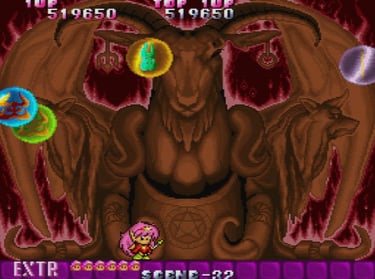
What's this? Those who complete both quests are in for a disturbing third. No full spoiler, but Rit and Tam must face an amalgam of ancient alien and demonic evil, severing the two lest the world be lost. It's a conspiracy of conspiracies.

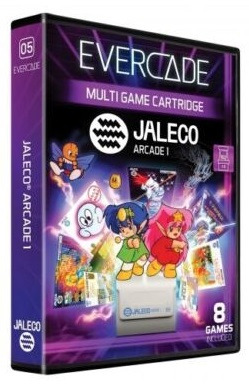
Owners of Blaze Entertainment's Evercade console can enjoy an optimized version of Rod-Land; unlike other releases (like the digital-only Arcade Archives), this edition is almost slowdown-free. Maybe not arcade perfect, then, but still the best way to experience the original game.
Contact: lostnostalgiaproductions@gmail.com
Website: www.lostnostalgia.com
Like what we're doing? Please consider throwing us a dollar into our Patreon page's tip jar!


